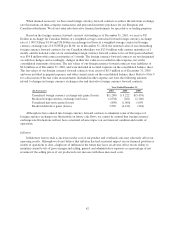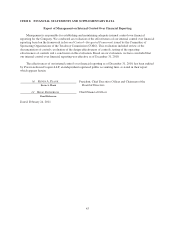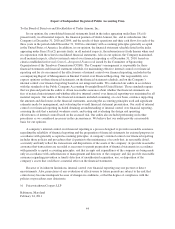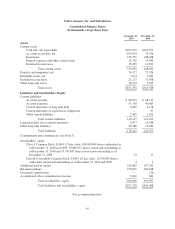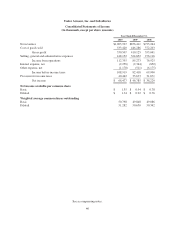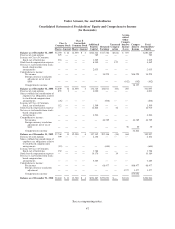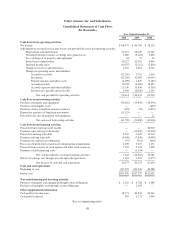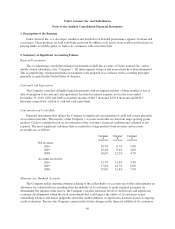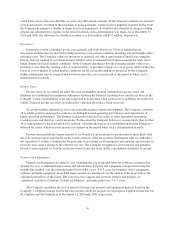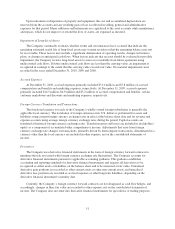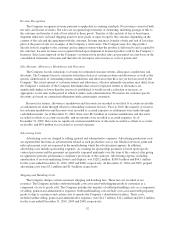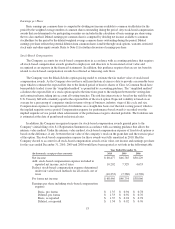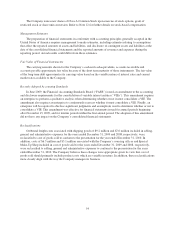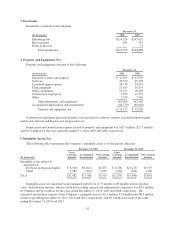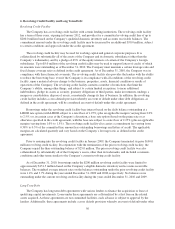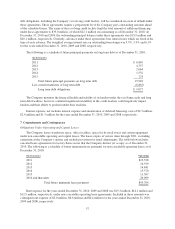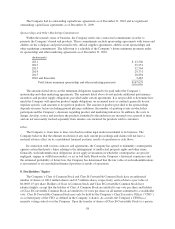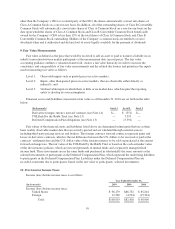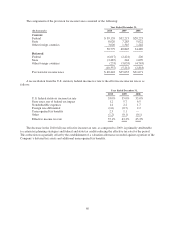Under Armour 2010 Annual Report Download - page 60
Download and view the complete annual report
Please find page 60 of the 2010 Under Armour annual report below. You can navigate through the pages in the report by either clicking on the pages listed below, or by using the keyword search tool below to find specific information within the annual report.Revenue Recognition
The Company recognizes revenue pursuant to applicable accounting standards. Net revenues consist of both
net sales and license revenues. Net sales are recognized upon transfer of ownership, including passage of title to
the customer and transfer of risk of loss related to those goods. Transfer of title and risk of loss is based upon
shipment under free on board shipping point for most goods or upon receipt by the customer depending on the
country of the sale and the agreement with the customer. In some instances, transfer of title and risk of loss takes
place at the point of sale, for example, at the Company’s retail stores. The Company may also ship product
directly from its supplier to the customer and recognize revenue when the product is delivered to and accepted by
the customer. License revenues are recognized based upon shipment of licensed products sold by the Company’s
licensees. Sales taxes imposed on the Company’s revenues from product sales are presented on a net basis on the
consolidated statements of income and therefore do not impact net revenues or costs of goods sold.
Sales Returns, Allowances, Markdowns and Discounts
The Company records reductions to revenue for estimated customer returns, allowances, markdowns and
discounts. The Company bases its estimates on historical rates of customer returns and allowances as well as the
specific identification of outstanding returns, markdowns and allowances that have not yet been received by the
Company. The actual amount of customer returns and allowances, which is inherently uncertain, may differ from
the Company’s estimates. If the Company determines that actual or expected returns or allowances are
significantly higher or lower than the reserves it established, it would record a reduction or increase, as
appropriate, to net sales in the period in which it makes such a determination. Provisions for customer specific
discounts are based on contractual obligations with certain major customers.
Reserves for returns, allowances, markdowns and discounts are recorded as an offset to accounts receivable
as settlements are made through offsets to outstanding customer invoices. Prior to 2010, the majority of reserves
for customer markdowns and discounts were recorded as accrued expenses as settlements were made through
cash disbursements. As of December 31, 2010, there were $8.3 million in customer markdowns and discounts
recorded as offsets to accounts receivable, and no amounts were recorded as accrued expenses. As of
December 31, 2009, there were no significant customer markdowns or discounts recorded as offsets to accounts
receivable, and $6.9 million was recorded as accrued expenses.
Advertising Costs
Advertising costs are charged to selling, general and administrative expenses. Advertising production costs
are expensed the first time an advertisement related to such production costs is run. Media (television, print and
radio) placement costs are expensed in the month during which the advertisement appears. In addition,
advertising costs include sponsorship expenses. Accounting for sponsorship payments is based upon specific
contract provisions and the payments are generally expensed uniformly over the term of the contract after giving
recognition to periodic performance compliance provisions of the contracts. Advertising expense, including
amortization of in-store marketing fixtures and displays, was $128.2 million, $108.9 million and $96.1 million
for the years ended December 31, 2010, 2009 and 2008, respectively. At December 31, 2010 and 2009, prepaid
advertising costs were $3.2 million and $1.4 million, respectively.
Shipping and Handling Costs
The Company charges certain customers shipping and handling fees. These fees are recorded in net
revenues. The Company includes outbound freight costs associated with shipping goods to customers as a
component of cost of goods sold. The Company includes the majority of outbound handling costs as a component
of selling, general and administrative expenses. Outbound handling costs include costs associated with preparing
goods to ship to customers and certain costs to operate the Company’s distribution facilities. These costs,
included within selling, general and administrative expenses, were $14.7 million, $12.2 million and $10.2 million
for the years ended December 31, 2010, 2009 and 2008, respectively.
52


